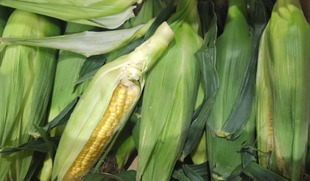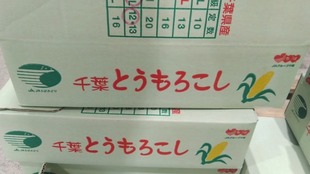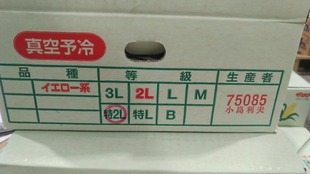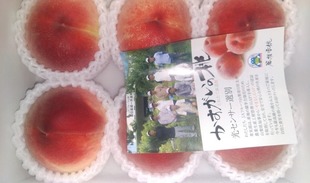Chiba Midori Agricultural Cooperative is located in the northeastern part of Chiba Prefecture, in a warm area with high agricultural productivity with various soil conditions such as sandy loam, loam, clay soil, and volcanic ash soil consisting of the Toso Plateau and the Kujukuri Plain. JA was born in January 2001 as one. As a production area that has been built up over many years, the members of the cooperative work hard at production while learning from the hardships and efforts of their predecessors, and bring benefits to us. The production situation in the jurisdiction is divided into upland farming, rice farming, livestock farming, dairy farming, fruit trees, and plants, and it seems that a wide variety of agricultural products are produced and sold. Taking advantage of the characteristics of early cultivation of rice, we are working on specially cultivated rice with reduced pesticides and chemical fertilizers, and for vegetables, we produce 60 items a year, including outdoor and indoor vegetables, and have many branded products. Agricultural product sales in FY2020 were 22,637,870,000 yen for horticulture, 1,776,450,000 yen for agricultural products, and 3,853,280,000 yen for livestock. As of the end of December 2022, the number of union members is 20,854, supporting future children from the Japanese dining table. As an overview of green onion production in the Sosa area, long onion cultivation in the jurisdiction has a long history, and it seems that it began in the Hikari-machi district (now Yokoshibahikari-machi) in the 1955s. Currently, the cultivation area has expanded to Sosa City and Asahi City, and it seems that the long green onions produced in the jurisdiction are branded as high-quality “Hikari green onion”. Cultivation is in autumn / winter, spring, satsuki satsuki, and summer, and 700,000 cases are shipped annually. In 1994, a central collection and shipping facility equipped with a pre-cooling storage facility began operation, enabling further quality improvement and shipping in accordance with customer requests. In recent years, the company has faced various challenges, such as an increase in cheap imported green onions, outbreaks of pests that are difficult to control, and the aging of producers. It seems that they are working to maintain and improve the brand’s production area. “地球の丸く見える丘展望館”, Located at the top of Mt. Atago, the highest in the northeastern part of the prefecture. I realized that the earth is round in the scenery seen from the rooftop observation space. Sunny day-You can see Mt. Fuji and Mt. Tsukuba in a 360-degree panorama.In addition, Byobugaura has a view of more than a dozen wind turbines. “補陀洛山 満願寺”, Established by Tokudo Saint, inheriting the history and tradition of pilgrimage since its inception. Shingon Buddhism (company or religious order founded in such a way): Principal image, Ekadasamukha (eleven-faced Avalokitesvara) Bodhisattva : Production By Horin Matsuhisa / Sorin ; Statue height 1 length 3 scale(90.909 cm), beautiful statue engraved on Japanese bishu cypress. 1974年, 弘法大師縁の坂東27番, 飯沼山圓福寺本尊写しの尊像 : It was created and enshrined as. Special sacred place of 88 places sacred place in Kanto – ふだらくやふくじゅむりょうのわだつみゆしおさしよするまんがんのてら, By the purification of related people who prayed for pilgrimage to the sacred sites of various countries including the Bando pilgrimage-Founded in 1976. “Soil making technology, chemical fertilizer reduction technology, pesticide reduction technology”. The purpose’s to make cultivation policies, cultivation standards, and cultivation plans(JAちばみどり). “Choshi City, Chiba Prefecture,” 三方を水に囲まれ,利根川河口から君ケ浜, 犬吠埼, 屏風ケ浦に, 至る海岸線が絶景である. Paleolithic : 旧石器時代, People started living on the peninsula about 15,000 to 23,000 years ago. “Choshi fishing port”, “Cool in summer and warm in winter”. “田中玄蕃”(石橋源右衛門: 旧海上郡飯沼村)が醤油: 1616年(元和2年)(ヒゲタ醤油株式会社, 創業者)浜口儀兵衛:西濱口家: 1645年(正保2年)(旧紀伊国有田郡広村: 現和歌山県有田郡広川町)から, 移住. The soy sauce industry in the Choshi area developed around the Genroku period Edo Era. City designated tangible cultural property (building) : 猿田神社本殿1棟, 猿田, 猿田神社, 昭和30年12月15日-常灯寺本堂1棟, 常世田町, 常灯寺(Shingon-shu Chizan-ha)昭和54年3月2日-海上八幡宮本殿1棟, 柴崎, 海上八幡宮, 平成2年3月16日4国-内野家住宅洋館1件, 長山町,個人, 平成11年7月8日-犬吠埼灯台1件, 平成22年4月28日-磯角商店主屋1件, 飯沼町,個人, 平成26年12月19日-旧犬吠埼霧信号所霧笛舎1件, 犬吠埼, 平成26年12月19日-滑川家住宅主屋ほか2件, 野尻町, 個人, 平成29年6月28日-旧西廣家住宅(治郎吉)主屋ほか, 川口町, 株式会社ランス, 平成30年3月27日-石上酒造米藏ほか5件, 田中町,個人. “Asahi City”, Yoshimasa KISO(19th descendant of General Asahi Yoshinaka KISO), a Sengoku warrior who ruled the area after the fall of the Muromachi Shogunate. 開基 : 殿玉山 西徳院 東漸寺, 1593(Shingon-shu Chizan-ha). 懸仏: A three-dimensional statue of Buddha(旭市指定文化財), 木曽義昌公遺跡(旭市指定文化財). It is said that he had good politics and was loved by the lords. Takamasa Nonokuchi(Okuni)-Kyoto poet: Time has passed and he visited in 1852 and wrote a poem. “信濃よりいづる旭をしたひ来て東のくにに跡とどめけむ”, I remembered Yoshimasa. Full of vigor and vitality (like the rising sun) (vigour); It also comes from the desire to develop with momentum in the future. Located in the northeastern part of the prefecture. It is located within 50 km from Chiba City and 80 km from the city center. The southern part faces the beautiful bow-shaped Kujukuri beach. ‘干潟八万石(Approximately 5,100 hectares of farmland changed from sea due to reclamation in 1670: 辻内 刑部左衞門-井戸野と仁玉間の排水路工事; 新川が完成, 椿海の排水開始)’, In the north(Boso Peninsula), a farm belt and a gentle hill zone, Hokso tableland, spread out. The surrounding area develops as an urban area. And the annual average temperature is 15 ℃, which is a warm climate. In industry: Institutional horticulture, livestock, rice farming, open-air vegetables, etc.Including active agriculture, fisheries, commerce, industry, etc., grow in a well-balanced manner. July 1, 2005: 旭市 / 海上町 / 飯岡町 / 干潟町(Area 130.45 km2), Born by merger.Expected to develop in the future as a nucleated city in the Toso region.旧石器時代: 約25,000年前-桜井遺跡, 縄文時代前期: 約6,000年前-九十九里海岸低地の形成, 縄文時代中期 / 後期: 約4,500年前- 仲島遺跡, 坊之場遺跡, 古墳時代後期: 6〜7世紀頃-東総地域最大の前方後円墳- 御前鬼塚古墳, 鏑木古墳群等, 大化元645年: 房総-安房 / 上総 / 下総, 下総国-香取/海匝 / 海上, 鎌倉時代前期: 13世紀- 東庄 / 三崎庄(千葉氏一族), 建長年間1250年頃: 然阿良忠(Ryochu Nena; 記主禅師)- 海匝 / 印旛地域(浄土宗)平安-鎌倉時代中期: 木造伝聖観音立像 / 木造阿弥陀如来(立像 / 絹本著色釈迦涅槃図)etc. 1826年: 宮負定雄-平田篤胤,“農業要集”, 1838年: 大原幽学-先祖株組合 ≒ “農業協同組合” – 長部村で結成, 1871年: 新治県, 1873年: 千葉県誕生, 1888年: 石橋太郎兵衛, 千本松喜助氏- 揚繰網開発, 1889年: パリの万国博覧会- 濤川惣助(七宝家)- 名誉大賞受賞, 1879年: 総武鉄道- 成東銚子間開通, 1912年: 穴澤松五郎- “穴澤式改良甘藷苗床; 改良増収穴沢式甘藷栽培法: 西ケ原刊行会, 1935”, etc. “Sosa City”, Located in the northeastern part of the prefecture.January 23, 2006: 八日市場市 / 野栄町, Was born by merging. It is about 70 km from Tokyo. The total area is 101.52 km2.It is famous as a city with abundant greenery and blessed nature and history. The northern part is a plateau with a complex terrain in which paddy field at valley bottom is intricate: A lot of nature of village-vicinity mountain is left. The southern part is flat land and most of it is rural except for urban areas: It faces the Kujukuri coast where which beautiful stretch of sandy beach dotted with pine trees continue. The climate is a warm oceanic climate: An average annual temperature of 15 degrees Celsius, cool in summer and warm in winter, a very comfortable place to spend.In addition, almost no snowfall can be seen even in winter. Legends and folk story : 駒まね, 薬師堂, 弘法の井戸, 火伏開運大黒天, 長者塚, 権左が西国, 古能葉稲荷大明神, 愛宕神社の天馬, 小詰, 雷塚, 田祖白石稲荷大明神, 火傷塚, 種われの梅, 昆布子のお女郎, 瑞董, 幸右衛門のおばあさん, 円静寺の忠犬, ゆるぎの松, 祟石, 飯高の供養塔, 裸詣り, 般若が原, 大寺の龍尾寺, 大浦瘡神, 曽我兄弟の墓, 木積の龍頭寺, 人魂の森, 薬王寺の薬師如来, お地蔵さま, 疣神様, 椿海, 新川「鎌数伊勢皇大臣」, 河童の証文松, 八百比丘と身払きの道祖神, 大根畑, 六社大神御神宝 “玉石” の由来, 西野田の鎮守六所大明神, 浅間神社と長貴さま, 円長寺の仁王様, 西宿鎮座八雲神社の不思議, 庄八, 朗生寺, 神沼のおっつあん, 尾合橋, チロリン橋, 子安神社. “Nara Todaiji Shoso-in Treasure Repository” – 庸調(So(租)-yo-cho in japan was a system modeled after china’s.)- The 741 record found in the special products delivered to the imperial court is the oldest. History book of the early Heian period; “Shoku Nihon Koki”- From the end of the 5th century to the beginning of the 6th century(畿内): 物部木蓮子の弟の物部小事(父; 物部布都久留). Current Kanto region: Bando- He was given a part of Shimousa Province by the imperial court for his merit. 匝瑳郡; さふさごおり- It is reported that the descendants named themselves Mr. Sosa Monobe. Return to a bright and beautiful city. Agriculture is land-use and intensive. In addition, mainly paddy rice, planting trees and facility vegetables such as tomatoes and strawberries: Open-air vegetables such as welsh onion, dairy, pig farming, poultry farming, etc. Complex management that combines them develops. In particular, the production of plants boasts one of the largest cultivated areas in Japan. It is said that it started in the Meiji era, and in the Taisho era(Podocarpus macrophyllus; 犬槇), it became a full-fledged occupation. “Yokoshibahikari Town, Sanbu District”, Located in the northeastern part of the prefecture. Kujukuri Beach, with its white sands in the south, and gentle hills in the north.The average annual temperature is 15 degrees Celsius, with cool summers and warm winters, with a pleasant climate. On March 27, 2006, sambu district yokoshiba town and Sousa District hikari town merged. The scenery of Kujukuri Beach, where the Pacific Ocean spreads magnificently, and the Kuriyama River, which flows through the central part of Yokoshibahikari Town, shines. It is a long and narrow terrain from north to south, and as it progresses from the flat coast to the plateau, it becomes slightly inland and the temperature difference. In general, it is blessed with natural conditions suitable for agriculture, which is cool in summer and warm in winter. Complex management that combines open-field vegetables and facility horticulture is flourishing centering on paddy agriculture. Paddy rice is the main crop, and sweet corn and leek are well known as open-field vegetables, such as tomatoes, squashes, and broccoli. There are also strawberry growers, and many are harvested from December to May and are popular. Working on high-profit crops, cherry tomato, melon in the greenhouse. Hydroponic mitsuba(Cryptotaenia canadensis (L.) DC.subsp. japonica (Hassk.) Hand. Mazz. (1933) cultivation, and in recent years, flower cultivation such as Cyclamen persicum has been carried out to improve management efficiency. Both pig farming and dairy farming are actively carried out. Speaking of representative agricultural products, welsh onions(Allium fistulosum L. var. bouddhae Prokh.). From around 1968, the cultivation of autumn and winter welsh onions became popular as a back crop of wheat, and in 1972, it was designated as a national production area. Plateau fields in the Houme Area and Kotabe Area were develoed from the 40’s to the 1950’s. After that, the cultivation method was improved and the brand continued to shine. Let’s explain the product. The top of the representative crops is green onion. From around 1968, autumn and winter green onion cultivation became popular as a back crop of wheat. In 1972, it was designated as a national production area. The fields will be improved from about 40 to 50 years, which will support the cultivation of green onions. Currently, both spring onions and autumn / winter green onions. 国指定無形民俗文化財: 鬼来迎, 虫生鬼来迎保存会, 昭和51年5月4日, 国指定記念物(史跡): 芝山古墳群, 大字中台字外記, 芝山仁王 観音教寺(天台宗)他, 昭和33年6月28日, 県指定有形文化財(彫刻): 木造薬師如来立像1躯, 宮川, 薬王院(真言宗智山派), 昭和29年3月31日, 県指定有形文化財(彫刻): 銅造阿弥陀如来及び両脇侍立像3躯, 小川台, 隆台寺(真言宗智山派), 昭和29年3月31日, 県指定有形文化財(彫刻): 木造阿弥陀如来坐像1躯, 木戸, 観音院(浄土宗), 昭和33年4月23日, 県指定有形文化財(彫刻): 銅造阿弥陀如来及び両脇侍立像3躯, 篠本, 殿谷山 新善光寺(真言宗智山派), 昭和57年4月6日, 県指定有形民俗文化財, 広済寺の鬼来迎面13面, 虫生, 慈士山 広済寺(真言宗智山派), 平成14年3月29日, 県指定記念物(史跡): 海保漁村先生誕生之處, 北清水他, 昭和14年12月15日, 県指定記念物(天然記念物): 町原大銀杏, 木戸台字町原, 平成31年3月5日. Choshi, Iioka, Unakami, Asahi, Sosa-Chiba Prefecture products corn is in season from mid-June to mid-July. Main varieties: ゴールドラッシュcorn(A variety developed and bred by Sakata Seed Co., Ltd. It is a yellow-grain variety with all yellow grains, and has been on the market since around 2002.), 味来corn(Developed in the United States, it is so popular that it has a very strong sweetness and soft skin, so it is also called Miracle Sweet Corn. It has a higher sugar content than other varieties, and is said to have an average sugar content of 12% or more. You can taste the strong sweetness even if you eat it raw, and it will increase even more if you heat it, and if you eat it boiled, the sweetness and juiciness will stand out even more. In addition, the arrangement of the grains is uniform, and the grains are well loaded, and the grains seem to grow to the tip.), 恵味G-corn(Raised by Shimizu Seed Co., Ltd. in Ichiba, Nagano City, Nagano Prefecture. The yellow grains are glossy and the grains are well packed. Naka-Wase yellow variety matures about 88 days after sowing in proper cultivation. It has a strong sweetness, and the grain skin is soft, and the taste is particularly excellent. Since the sugar content is low and the skins are slow to shrivel, there is a wide range of suitable harvesting periods and the ability to maintain freshness is said to be outstanding.), ピュアホワイトcorn(Developed by Snow Brand Seed Co., Ltd. (Atsubetsu Ward, Hokkaido), a member of the Megmilk Snow Brand(雪印メグミルク)Group, it is a Nakate variety that can be harvested in about 88 days after sowing, and it bears fruit all the way to the tip. White grains that do not become dull even when boiled, have a strong sweetness, and the skin is soft and easy to eat. It seems to be suitable for restraint cultivation.). Annual shipment volume, 667,000 cases (1 case = 5 kg).
Chiba Prefecture’s Teachings According to Chiba’s bounty, corn is one of the vegetables that loses its freshness the most. It is recommended to eat it as soon as possible because the composition changes drastically after harvesting. Try to boil or bake them as soon as you get them. If you can’t eat it all, it seems to be useful to freeze the boiled ones. If you want to save it, soak the cut end in water, or soak a newspaper in water and wrap it tightly and store it in the vegetable compartment of the refrigerator. Freshness and harvest time are key points when choosing. It seems that the ones with the skin on are better than the peeled ones. The skin is juicy and the tip of the flag leaf is sharp, the skin is dark green, and the hair is brown or blackish brown. There is a possibility that those that are swollen or those that do not swell at the tip are immature. It seems that late-harvested grains have hardened skins and become dry and less sweet. The male flowers of corn are the spike-like spikes of the corn at the tip of the stalk, and the female flowers are attached to the silk thread on the head of the corn. The pollen that comes out of the male flower at the tip of the stalk is blown by the wind to the tip of the pistil and bears fruit. If the pollination is normal, the number of fruits will be the same as the number of silk threads. This excellent agricultural product was considered to be a phenomenon different from the “law of heredity” of Gregor Johann Mendel (1822-1884), who was born in Xenia (now Czech Republic), but the mechanism of double fertilization peculiar to angiosperms was clarified. As a result, the mechanism of this phenomenon has also been solved. The pollen that scatters from the dent corn pollinates the pistil of the sweet corn, and then fertilization occurs. The germinating pollen has two male nuclei and the ovule egg in the pistil. The nucleus and polar nucleus are fertilized to form the seed embryo and endosperm, respectively. The male nucleus carries half of the parent’s genetic information and, if it is a dominant trait, produces seeds of the color and taste of dent corn. The whisker-like pistil grows, and each of them pollinates and fertilizes. It seems that seeds and seeds of different colors and shapes can be formed on one ear depending on the traits of the male nucleus.), and the influence of pollen seems to appear immediately. In order to cultivate yellow, white, and bicolor flowers according to their original characteristics, it seems necessary to prevent other pollen from entering. It is necessary to pay attention to the direction of the wind and the separation distance from other varieties.
Chiba Prefecture is known as a “treasure trove of food” because it produces a variety of agricultural, forestry and fishery products. The freshness of the corn is important, so the fresh, juicy corn grown locally in Chiba Prefecture is the most recommended. It is also cultivated throughout the prefecture. In 2018, the production value was 3.6 billion yen, and the planted area was 1,750 ha, making it the second largest production area in Japan in terms of both production value and planted area. This excellent produce is characterized by its sweet, fruity aroma and refreshing texture, and is a unique taste that can be enjoyed by adults and Kid’s alike. Since the sugar content decreases after harvesting, each production area in the prefecture is working on quality improvement, such as developing morning picking and vacuum pre-cooling facilities, making it fresher and more juicy.
Sweet corn harvested early in the morning, when it tastes the most delicious, is pre-cooled in a vacuum at the collection point (excess moisture evaporates during cooling, so quality is maintained even when harvested in the rain) and shipped chilled to the core, ensuring freshness. It is shipped to the market and consumers with sincerity while maintaining the.












